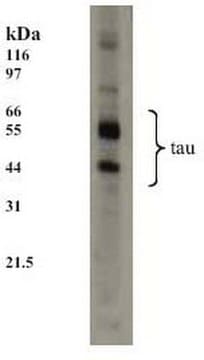推荐产品
生物来源
rabbit
质量水平
偶联物
unconjugated
抗体形式
affinity isolated antibody
抗体产品类型
primary antibodies
克隆
polyclonal
表单
buffered aqueous glycerol solution
种属反应性
rat, mouse, human
技术
microarray: suitable
western blot: suitable
UniProt登记号
运输
wet ice
储存温度
−20°C
靶向翻译后修饰
phosphorylation (pSer199/pSer202)
基因信息
human ... MAPT(4137)
mouse ... Mapt(17762)
rat ... Mapt(29477)
一般描述
Tau(τ),别名MAPT(微管相关蛋白tau),由位于人染色体17q21.3上的基因编码。高度表达于神经元细胞,在轴突中浓度最高。
Tau蛋白属微管相关磷蛋白(MAP),主要在中枢神经系统神经元中表达。在微管蛋白聚合中发挥重要作用,促进微管装配和稳定。tau蛋白的生物活性取决于其磷酸化程度。抗-磷酸化Tau(pSer199/202)抗体可用于微阵列和蛋白质印迹分析(western blotting)。还可用于免疫印迹分析。兔抗-磷酸化Tau (pSer199/202)抗体与人Tau (pSer199/202)(45-68 kD)特异性反应。
免疫原
化学合成人tau蛋白含丝氨酸199和丝氨酸202区域来源的磷酸肽。
应用
兔生产的抗-磷酸化Tau(pSer199/202)抗体已用于:
- 免疫细胞化学
- 免疫组织化学
- 蛋白质印迹(western blot)
抗-磷酸化Tau (pSer199/202)抗体(用含0.3% Triton X-100和0.5% BSA的PBS1:1000稀释)可用于通过免疫细胞化学法鉴定蛋白聚集体。还可作为一抗(1: 3000稀释)用于免疫组织化学分析。
生化/生理作用
Tau(τ)在微管结构的组装和维持中起着至关重要的作用。tau(τ)缺失会导致发育迟缓和学习困难。其基因表达与阿尔茨海默症(AD)的发展有关。τ基因变异会提高罹患散发性tau蛋白病(sporadic tauopathies)、进行性核上性麻痹(PSP)和皮质基底节变性的风险。
外形
溶于100 μl 杜氏磷酸盐缓冲液(不含Mg2+和Ca2+),pH 7.3,含50%甘油、1.0 mg/ml BSA(IgG,无蛋白酶)和0.05%叠氮化钠。本品的抗体量足够进行10次免疫印迹分析。
免责声明
除非我们的产品目录或产品附带的其他公司文档另有说明,否则我们的产品仅供研究使用,不得用于任何其他目的,包括但不限于未经授权的商业用途、体外诊断用途、离体或体内治疗用途或任何类型的人类或动物食用或应用。
未找到合适的产品?
试试我们的产品选型工具.
警示用语:
Warning
危险声明
预防措施声明
危险分类
Eye Irrit. 2 - Skin Irrit. 2
储存分类代码
10 - Combustible liquids
WGK
WGK 3
闪点(°F)
320.0 °F - closed cup
闪点(°C)
160 °C - closed cup
Yan-Bin Shi et al.
Frontiers in aging neuroscience, 12, 596894-596894 (2020-12-29)
Dystrophic neurites (DNs) are found in many neurological conditions such as traumatic brain injury and age-related neurodegenerative diseases. In Alzheimer's disease (AD) specifically, senile plaques containing silver-stained DNs were already described in the original literature defining this disease. These DNs
Tian Tu et al.
Frontiers in aging neuroscience, 12, 93-93 (2020-06-02)
Amyloid plaques and neurofibrillary tangles (NFTs) are hallmark lesions of Alzheimer's disease (AD) related to β-amyloid (Aβ) deposition and intraneuronal phosphorylated tau (pTau) accumulation. Sortilin C-terminal fragments (shortened as "sorfra") can deposit as senile plaque-like lesions within AD brains. The
Feng-Qin Zhou et al.
Alzheimer's research & therapy, 10(1), 40-40 (2018-04-25)
Alzheimer's disease (AD) is a devastating neurodegenerative disorder bearing multiple pathological hallmarks suggestive of complex cellular/molecular interplay during pathogenesis. Transgenic mice and nonhuman primates are used as disease models for mechanistic and translational research into AD; the extent to which
Gamma radiation improves AD pathogenesis in APP/PS1 mouse model by potentiating insulin sensitivity.
Mayuri Khandelwal et al.
Heliyon, 6(7), e04499-e04499 (2020-08-11)
Alzheimer's disease (AD) is the largest unmet medical complication. The devastation caused by the disease can be assumed from the disease symptoms like speech impairment, loss of self-awareness, acute memory loss etc. The individuals suffering from AD completely depend on
Michael F Almeida et al.
Arquivos de neuro-psiquiatria, 74(9), 737-744 (2016-10-06)
Cell physiology is impaired before protein aggregation and this may be more relevant than inclusions themselves for neurodegeneration. The present study aimed to characterize an animal model to enable the analysis of the cell biology before and after protein aggregation.
我们的科学家团队拥有各种研究领域经验,包括生命科学、材料科学、化学合成、色谱、分析及许多其他领域.
联系技术服务部门









